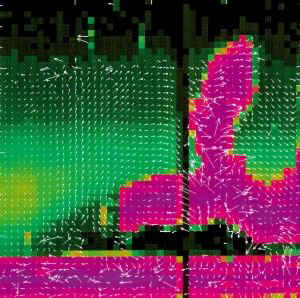DRIFT MODES
DRIFT MODES
The main outputs of these modes are the zonal drifts and/or the vertical drifts. Drift velocity measurements can be made with very high accuracy at Jicamarca because it is possible to point the beam perpendicular to the magnetic field. With this orientation the signal correlation times become very long and the velocities are easily obtained from the phase of the ACF [ Woodman and Hagfors, 1969]. Alternatively, from a frequency domain point of view, the spectrum of the scattered signal becomes very narrow, making it easy to measure small Doppler shifts. As a result, accurate vertical and east-west F-region drift velocities, and hence electric fields, have been routinely obtained at Jicamarca for many years. On the other hand, it is much harder to measure north-south velocities accurately. Some measurements of meridional drift have been made, but there appears to be an unexplained systematic bias in the data taken so far.

The vertical drifts can be obtained by either pointing the whole Jicamarca antenna (both polarizations) perpendicular to B (vertical drift mode) or by using two quasi symmetric beams pointing perpendicular to B to the East and West (East-West Drift mode). The first mode allows the measurements of relative electron densities, while the latter also allows the measurements of the zonal drifts.
The program of vertical and zonal drift measurements at Jicamarca began in the late 1960s with a pulse-to-pulse processing scheme. Pulse-to-pulse analysis results in significant reductions in statistical estimation errors of drift velocities derived from noisy correlation phase data. Furthermore, self-clutter is eliminated, and drift measurements are not affected by systematic “chirp errors” that may arise in multipulse applications.
The uncertainties in F region E x B line-of-sight drift estimates obtained at Jicamarca with the pulse-to-pulse correlation method outlined above (see the original description by Woodman and Hagfors [1969] for more details) can be as low as about 2 m/s (or 50 μV/m in terms of equivalent electric field) when the radar is operated to provide 5min time and 15 km height resolutions. Consequently, the high-precision F region drifts data collected at the Jicamarca Radio Observatory over the past 2 decades constitute a very accurate and unique information source concerning the electrodynamics of the low-latitude ionosphere. The database is one of the primary resources used for studies of seasonal and solar cycle variations in equatorial electrodynamics, as well as the response of the low-latitude ionosphere to magnetospheric forcing. The vertical component of equatorial E x B drift monitored at Jicamarca has also been identified as the single most crucial input parameter required by the low latitude ionospheric models for predicting the behavior of the ionosphere up to the anomaly region, and possibly forecasting the occurrence of equatorial spread F.
Since 1996 incoherent scatter F region plasma drift measurements at Jicamarca have been implemented using a new signal processing approach replacing the traditional pulse-to-pulse correlation method. The new method, based on Doppler spectrum estimation and nonlinear least squares fitting to model spectra obtained from incoherent scatter theory, improves the instrumental sensitivity remarkably under low signal-to-noise conditions. With the new method it has become possible to obtain very high quality drifts data at nearly all hours of the day throughout most F region heights. Altitudinal smoothing of the drifts data to reduce measurement noise is no longer necessary, and studies of the height variations of drifts can be performed with much greater certainty than before. Small-amplitude gravity wave oscillations have been detected at F region heights and a vertical circulation of the F region plasma has been observed in the post sunset period [Kudeki and Bhattacharyya, 1999]. This new approach can be applied to either the vertical or the east-west drift modes (Specific details are given by Kudeki et al. [1999]).
Typical experimental parameters are: IPP=1000 km, PW = 45 km (Barker coded), Sampling range = 15 km, sampling range= 45-960 km. Raw data voltages are recorded in addition to 20 second integrated spectra and cross spectra functions. The latest measurements can be found in Madrigal Database and also at http://skylite.csl.uiuc.edu/jro-isr/ .



